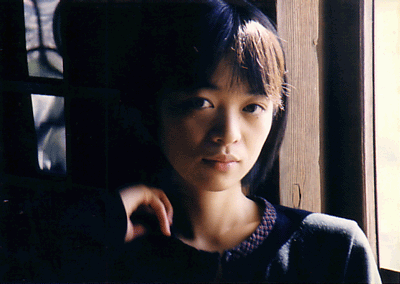
The best thing I love from Japan: my beautiful wife. Picture taken November 2000, from inside Himeji Castle.
![]()

The best thing I love from Japan: my beautiful wife. Picture taken November 2000, from inside Himeji Castle.
![]()
OK, so you already know that there is so much to love about Japan: fascinating history and culture, wonderful pop culture (including music, manga, anime, actors in silly rubber monster suits) and incredible tourist spots. You may already know about my experiences in Japan if you've read Greg's Life and have watched my YouTube videos. When I lived in Japan, I spent a lot of energy griping about stuff I didn't like about Japan, like how banks were only open from 10am to 3pm, and they charged fees to use their ATMs on weekends. But ever since I had lived there, I've been wanting to make a page about all the neat stuff about Japan that I love. Some of this will be obvious stuff and things people probably already know about. I just want to just focus on the random things that make me happy about Japan. So here they are, in no particular order.
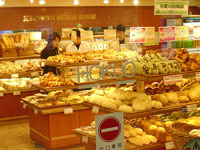 Bakeries. At Easter dinner with my extended family last year, we told everyone how much our daughter Ulan loves bread. One member of my extended family who will go unnamed then made a comment to the effect that since Mayu was planning on visiting Japan for three months, that it would be unfortunate that Ulan would not have access to bread for that whole time. OK, so out of respect, we didn't snicker or laugh. When I lived in Japan, I found it hilarious how people thought that since I was American, that I did not eat rice. This ignorance is just silly, and here a member of my family, who I thought would've known better, said something just as crazy. We told this family member that bakeries in Japan are far, far better than the crap we have here in Phoenix, Arizona. Simply put, these bakeries are fantastic. Here in Phoenix, you have to search for the high-end bakeries such as in Whole Foods supermarkets or even the local Japanese bakeries to match these bakeries that can be found everywhere in Japan. Melon pan, curry donuts, those egg and sausage rolls... Oh man, I can't wait to visit one again. Bakeries. At Easter dinner with my extended family last year, we told everyone how much our daughter Ulan loves bread. One member of my extended family who will go unnamed then made a comment to the effect that since Mayu was planning on visiting Japan for three months, that it would be unfortunate that Ulan would not have access to bread for that whole time. OK, so out of respect, we didn't snicker or laugh. When I lived in Japan, I found it hilarious how people thought that since I was American, that I did not eat rice. This ignorance is just silly, and here a member of my family, who I thought would've known better, said something just as crazy. We told this family member that bakeries in Japan are far, far better than the crap we have here in Phoenix, Arizona. Simply put, these bakeries are fantastic. Here in Phoenix, you have to search for the high-end bakeries such as in Whole Foods supermarkets or even the local Japanese bakeries to match these bakeries that can be found everywhere in Japan. Melon pan, curry donuts, those egg and sausage rolls... Oh man, I can't wait to visit one again.
| |
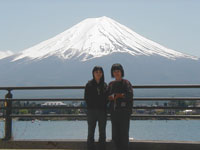 Mt. Fuji One of the iconic symbols of Japan, Mt. Fuji is a sight to behold. Just as the Eiffel Tower is visible through pretty much every single window in Paris, Mt. Fuji is similarly represented as a symbol of Japan that is ubiquitously depicted to the point that it can be hilarious. Regardless of it being in a picture, movie, comic, clothing or whatever you can think of, it's as if the creator of the medium is saying, "See? Japan, huh?" This picture is of my wife and mom-in-law, and we really lucked out to be able to visit Mt. Fuji on this beautiful, clear day. Visiting this mountain in Yamanashi-ken most other times, you have a good chance that only the base of the mountain will be visible as it is often enshrouded in cloud cover. Sure, there are taller mountains (elevation-wise) even here in Arizona where I live, but the way Mt. Fuji majestically rises from sea level to embrace the sky, towering above the cloud line, is just a sight to behold. Mt. Fuji One of the iconic symbols of Japan, Mt. Fuji is a sight to behold. Just as the Eiffel Tower is visible through pretty much every single window in Paris, Mt. Fuji is similarly represented as a symbol of Japan that is ubiquitously depicted to the point that it can be hilarious. Regardless of it being in a picture, movie, comic, clothing or whatever you can think of, it's as if the creator of the medium is saying, "See? Japan, huh?" This picture is of my wife and mom-in-law, and we really lucked out to be able to visit Mt. Fuji on this beautiful, clear day. Visiting this mountain in Yamanashi-ken most other times, you have a good chance that only the base of the mountain will be visible as it is often enshrouded in cloud cover. Sure, there are taller mountains (elevation-wise) even here in Arizona where I live, but the way Mt. Fuji majestically rises from sea level to embrace the sky, towering above the cloud line, is just a sight to behold.
| |
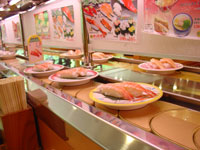 100 yen kaiten zushi restaurants. In the West, sushi was first embraced by fairly affluent people and thus sushi has become stigmatized as being a fancy style of food to enjoy when you have the money. Spend possibly $15 and up per person, it's an indulgence to savor. Then you have to drive your kids to Burger King afterwards because they refuse to eat sushi. But in Japan, sushi is everywhere, and it is just another food for the family to enjoy together. It can be fancy, or it can be cheap. Kappa Sushi is my favorite place to eat lots of cheap sushi. Most plates go for a hundred yen each, while some plates may be more. Sure, Kappa isn't the fanciest sushi restaurant, but you won't go broke and still, as the Coneheads on SNL say, "consume mass quantities." Either while sitting at the bar or in booths, just grab sushi plates as they go by. If you don't see what you like, you can either press a button to request it from the chef, or more recently there is a touch-sensitive video screen in which you can place your requests. Your sushi order will pass by on a reserved pedestal, or what's even cooler is at restaurants where your order will arrive at your table via a little toy shinkansen (gosh, I love trains). Grab it, then send the train back to the kitchen. Hot water is dispensed from a spigot in front of you, to fill your cup for green tea. Afterwards, your bill is totaled by the waitress by counting each of the color-coded plates that signify the price of each. 100 yen kaiten zushi restaurants. In the West, sushi was first embraced by fairly affluent people and thus sushi has become stigmatized as being a fancy style of food to enjoy when you have the money. Spend possibly $15 and up per person, it's an indulgence to savor. Then you have to drive your kids to Burger King afterwards because they refuse to eat sushi. But in Japan, sushi is everywhere, and it is just another food for the family to enjoy together. It can be fancy, or it can be cheap. Kappa Sushi is my favorite place to eat lots of cheap sushi. Most plates go for a hundred yen each, while some plates may be more. Sure, Kappa isn't the fanciest sushi restaurant, but you won't go broke and still, as the Coneheads on SNL say, "consume mass quantities." Either while sitting at the bar or in booths, just grab sushi plates as they go by. If you don't see what you like, you can either press a button to request it from the chef, or more recently there is a touch-sensitive video screen in which you can place your requests. Your sushi order will pass by on a reserved pedestal, or what's even cooler is at restaurants where your order will arrive at your table via a little toy shinkansen (gosh, I love trains). Grab it, then send the train back to the kitchen. Hot water is dispensed from a spigot in front of you, to fill your cup for green tea. Afterwards, your bill is totaled by the waitress by counting each of the color-coded plates that signify the price of each.
| |
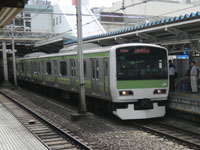 Trains. I like trains. Trains are nice and good. I've loved trains ever since I was a kid. I had a Union Pacific model railroad that was never really put together, aside from a circular test track and some plastic model buildings I built. But anyhow, trains have always fascinated me. The subway in Los Angeles, the trolley in San Diego, the BART in San Francisco, and now even the light rail here in Phoenix. Even though I currently take the train to work in downtown Phoenix, it's just not the same as the trains in Japan. From the shinkansen to the local trains and subways, they're all wonderful to ride. Sure, they can get packed like crazy during rush hour, and the sushi zume ("packed like sushi") phenomenon is not at all comfortable. However, the trains are extremely efficient and punctual, and therefore completely dependable. Especially charming are the melodies played at the train stations when the trains arrive. The stations of the Yamanote line in Tokyo are particularly memorable, and CDs of these melodies can be bought on Amazon Japan. I used it to make cell phone ringtones. I made a video of this on YouTube here. Trains. I like trains. Trains are nice and good. I've loved trains ever since I was a kid. I had a Union Pacific model railroad that was never really put together, aside from a circular test track and some plastic model buildings I built. But anyhow, trains have always fascinated me. The subway in Los Angeles, the trolley in San Diego, the BART in San Francisco, and now even the light rail here in Phoenix. Even though I currently take the train to work in downtown Phoenix, it's just not the same as the trains in Japan. From the shinkansen to the local trains and subways, they're all wonderful to ride. Sure, they can get packed like crazy during rush hour, and the sushi zume ("packed like sushi") phenomenon is not at all comfortable. However, the trains are extremely efficient and punctual, and therefore completely dependable. Especially charming are the melodies played at the train stations when the trains arrive. The stations of the Yamanote line in Tokyo are particularly memorable, and CDs of these melodies can be bought on Amazon Japan. I used it to make cell phone ringtones. I made a video of this on YouTube here. Another thing about Japanese trains is that they aren't full of psychotic morons, thugs, and weirdos like the trains in America are, like the one I take to work. I often wear earphones even if they aren't plugged into anything just to avoid people, especially those who want to strike up a conversation with me, and then I'd have to endure their inane banter while all I want to do is read my SF novel. Crap, I hate that. | |
 Engrish. OK, so this is an easy one. Who doesn't enjoy Engrish? Well, members of my extended family apparently don't find the humor in the Engrish shirts I wear. They just think it's strange. Well, pooie on them! The English language is a rather convoluted one, and Japan's attempts to use nonsensical English literally as mere decorations. I think a lot of Engrish must be intentionally weird. But it's no worse than idiot Americans who get kanji tattoos of what they think their name is. There was this one dude I saw in the college computing center at ASU West where I was a student worker. His kanji was "lord dirt." So I asked him why he had a tattoo of "lord dirt" on his arm, and he said it was his name "Steve" in Chinese. Shuu chi. Steve. Yeah, sure. I can see that. So lame. But anyway, Engrish is great fun. If you don't find Engrish to be funny and delightful, you had better have some pretty strongly redeeming qualities about you to persuade me to like you. If not, you suck. Engrish. OK, so this is an easy one. Who doesn't enjoy Engrish? Well, members of my extended family apparently don't find the humor in the Engrish shirts I wear. They just think it's strange. Well, pooie on them! The English language is a rather convoluted one, and Japan's attempts to use nonsensical English literally as mere decorations. I think a lot of Engrish must be intentionally weird. But it's no worse than idiot Americans who get kanji tattoos of what they think their name is. There was this one dude I saw in the college computing center at ASU West where I was a student worker. His kanji was "lord dirt." So I asked him why he had a tattoo of "lord dirt" on his arm, and he said it was his name "Steve" in Chinese. Shuu chi. Steve. Yeah, sure. I can see that. So lame. But anyway, Engrish is great fun. If you don't find Engrish to be funny and delightful, you had better have some pretty strongly redeeming qualities about you to persuade me to like you. If not, you suck.Here is a picture of a shirt I took that was featured on engrish.com. | |
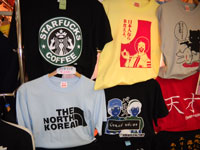 Funny shirts. This ties in with the Engrish category above. Some of them are in English, but a lot of them are in Japanese. Check out Pazu and Sheeta in a Dragon Quest spoof: "balse" is not a correct spell summon. Ronald McDonald is telling you that if you're Japanese, eat rice. And check out Hello Kitty after her head shot to Miffy! So cool. I have a couple myself: one of Colonel Sanders murdering chickens and another one of Pedo Bear raking Ronald McDonald across the face with claws. Check out these shirts I featured in a video of mine on YouTube. Funny shirts. This ties in with the Engrish category above. Some of them are in English, but a lot of them are in Japanese. Check out Pazu and Sheeta in a Dragon Quest spoof: "balse" is not a correct spell summon. Ronald McDonald is telling you that if you're Japanese, eat rice. And check out Hello Kitty after her head shot to Miffy! So cool. I have a couple myself: one of Colonel Sanders murdering chickens and another one of Pedo Bear raking Ronald McDonald across the face with claws. Check out these shirts I featured in a video of mine on YouTube.
| |
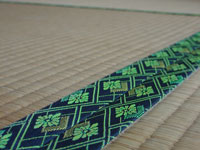 Tatami mats. Gosh, I don't really think much of these when I am in Japan, but when I am not there, when I think of them I can see the skilled craftsmanship and artistry in the making of these mats. Tatami mats are all the same size, and rooms are measured in the number of mats that can fit into the floorspace. Even rooms that do not have tatami mats are measured in terms of these mats, so having a good idea of how large these mats are will help you when selecting a house or apartment to rent in Japan. Tatami mats. Gosh, I don't really think much of these when I am in Japan, but when I am not there, when I think of them I can see the skilled craftsmanship and artistry in the making of these mats. Tatami mats are all the same size, and rooms are measured in the number of mats that can fit into the floorspace. Even rooms that do not have tatami mats are measured in terms of these mats, so having a good idea of how large these mats are will help you when selecting a house or apartment to rent in Japan.
| |
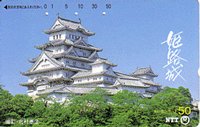 Telephone cards. It's such a hassle trying to get correct change for a payphone. But with a phone card in Japan, this problem is solved! Just insert the card into the public pay phone, and the phone will digitally keep track of your remaining minutes. It will perforate a hole in the card to display the time remaining on the card. This phone card is of Himeji Castle. Telephone cards. It's such a hassle trying to get correct change for a payphone. But with a phone card in Japan, this problem is solved! Just insert the card into the public pay phone, and the phone will digitally keep track of your remaining minutes. It will perforate a hole in the card to display the time remaining on the card. This phone card is of Himeji Castle.
| |
 Furniture. I love Japanese furniture, especially the ones that are so low to the ground. Zaisu are floor chairs, perfect for parking one's ass in front of the TV to play video games. Sofas can also come legless, perfect for being lazy and lounging about. When they are low to the ground, they don't seem to take up as much space in your place, giving your place the feel of being roomier. That counts for a lot in Japan, I think. Furniture. I love Japanese furniture, especially the ones that are so low to the ground. Zaisu are floor chairs, perfect for parking one's ass in front of the TV to play video games. Sofas can also come legless, perfect for being lazy and lounging about. When they are low to the ground, they don't seem to take up as much space in your place, giving your place the feel of being roomier. That counts for a lot in Japan, I think.
| |
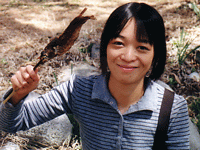 Weird food on sticks. What's this? Who cares? OM NOM NOM NOM. Many types of Japanese food can come on sticks. Everyone seems to know about yakitori, but some of these foods can be rather mysterious. Here's a pic of my wife eating a dried fish on a stick. Because it's been smoked and dried, the bones are also edible. Weird food on sticks. What's this? Who cares? OM NOM NOM NOM. Many types of Japanese food can come on sticks. Everyone seems to know about yakitori, but some of these foods can be rather mysterious. Here's a pic of my wife eating a dried fish on a stick. Because it's been smoked and dried, the bones are also edible.
| |
 J-Pop. On average, Japanese pop music is just pleasant to listen to. It's not sleazy or threatening or irritable. Of course there are exceptions to the irratable part. Take for example 2001's top hit "Ashita Ga Aru" by Ufuls (I prefer to pronounce this as "you fools"). They played that song to death and it made me crazy. On the other hand, my friends back in the States were telling me about this annoying "Who Let The Dogs Out" song that was played to death, and when I finally heard it, I realized how better off I was. Sure, J-Pop is pretty fluffy and generic, but if I had to choose to either listen to Japanese pop music or to be subjected to Britney "Look At My Boobies" Spears, Backdoor Boys, N'Suc, or angst-ridden nonsense like Link-N-Logs or whatever they're called. J-Pop. On average, Japanese pop music is just pleasant to listen to. It's not sleazy or threatening or irritable. Of course there are exceptions to the irratable part. Take for example 2001's top hit "Ashita Ga Aru" by Ufuls (I prefer to pronounce this as "you fools"). They played that song to death and it made me crazy. On the other hand, my friends back in the States were telling me about this annoying "Who Let The Dogs Out" song that was played to death, and when I finally heard it, I realized how better off I was. Sure, J-Pop is pretty fluffy and generic, but if I had to choose to either listen to Japanese pop music or to be subjected to Britney "Look At My Boobies" Spears, Backdoor Boys, N'Suc, or angst-ridden nonsense like Link-N-Logs or whatever they're called. Some Japanese bands are actually quite nice. Lately I've discovered Advantage Lucy. Any band that names themselves after Peanuts characters is cool, in my opinion. Other great Japanese indie bands I've come to like are Waffles, Hartfield, Nanocycle, Monocism, and My Dead Girlfriend. | |
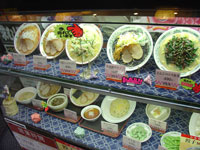 Ramen. I likes me some ramen! If all you've ever had is the packaged cup ramen from super markets, then you are missing out. Shoyu, miso, shio, tonkotsu... I love it all. I'm just not a fan of corn in my ramen, though. But anyhow, my favorite has got to be chashu miso (sliced BBQ pork) ramen. Add lots of bamboo shoots and bean sprouts, then top it off with some Chinese white pepper. It's TEH NOMZ. The best ramen places have the ramen set, which is ramen that comes with a side of chahan (fried rice) and gyoza (potstickers). My favorite all-around place is Ohshou, a Chinese restaurant chain that's popular in the Kansai area. I only know of one Ohshou in Tokyo, and it's right next to the entrance to the Nakano Broadway Building. When we lived in Himeji, my wife and I would go on Friday night dates to this place called Nikuni that had fantastic ramen, gyoza, and chahan. After dinner, we would walk over to the Rios building, which had a big entertainment center that's similar to Round 1 if you've seen those before. It has a bowling alley, billiards, ping pong tables, and a game arcade all on the top floor of the building. But anyhow, I'll get to the topic of game centers next! Ramen. I likes me some ramen! If all you've ever had is the packaged cup ramen from super markets, then you are missing out. Shoyu, miso, shio, tonkotsu... I love it all. I'm just not a fan of corn in my ramen, though. But anyhow, my favorite has got to be chashu miso (sliced BBQ pork) ramen. Add lots of bamboo shoots and bean sprouts, then top it off with some Chinese white pepper. It's TEH NOMZ. The best ramen places have the ramen set, which is ramen that comes with a side of chahan (fried rice) and gyoza (potstickers). My favorite all-around place is Ohshou, a Chinese restaurant chain that's popular in the Kansai area. I only know of one Ohshou in Tokyo, and it's right next to the entrance to the Nakano Broadway Building. When we lived in Himeji, my wife and I would go on Friday night dates to this place called Nikuni that had fantastic ramen, gyoza, and chahan. After dinner, we would walk over to the Rios building, which had a big entertainment center that's similar to Round 1 if you've seen those before. It has a bowling alley, billiards, ping pong tables, and a game arcade all on the top floor of the building. But anyhow, I'll get to the topic of game centers next!What is also interesting is that most ramen restaurants have a small library of manga to read. | |
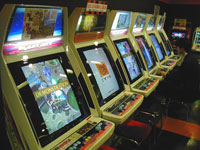 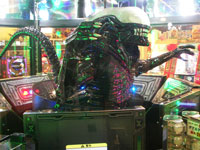 Game centers. Despite the number of game centers diminishing in Japan, as well as the actual numbers of arcade games also diminishing due to the proliferation of purikura and UFO Catchers, game arcades in Japan remain awesome. So maybe there aren't as many as there used to be. But those that remain are still full of win. Game centers. Despite the number of game centers diminishing in Japan, as well as the actual numbers of arcade games also diminishing due to the proliferation of purikura and UFO Catchers, game arcades in Japan remain awesome. So maybe there aren't as many as there used to be. But those that remain are still full of win. Fighting games, gun games, puzzle games, shmups, and of course the ubiquitous musical rhythm or dance games. They's super fun. Most games cost 100 yen to play, but if you can find a 50 yen arcade, you're set. | |
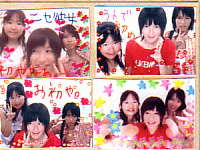
 Purikura. Purikura (Print Club) booths are super fun. I used to take plenty of purikura of myself, my friends, and my wife and would trade these with my students. Boy students didn't seem to care much for these, so it was mainly all the girls. I had collected quite a few from students from the schools I taught at. The ones in the picture on the left are some students of mine. On the right is Tokyo Tower growing out of my head, with Galen and Brian during our week in Tokyo together. Purikura. Purikura (Print Club) booths are super fun. I used to take plenty of purikura of myself, my friends, and my wife and would trade these with my students. Boy students didn't seem to care much for these, so it was mainly all the girls. I had collected quite a few from students from the schools I taught at. The ones in the picture on the left are some students of mine. On the right is Tokyo Tower growing out of my head, with Galen and Brian during our week in Tokyo together.I must complain though. I preferred the original style of purikura, the ones that came with various set backgrounds to choose from and came on peel away sheets. Modern purikura require scissors to cut out and although you can write all over them with the video stylus before printing, they just aren't as cool as the old ones, I think. | |
 UFO catchers. Prize catcher games in the USA feature a joystick and a button that once you press it, the claw goes down to grab whatever you are aiming for. Typical UFO catchers in Japan just feature two buttons: one button that goes either right or left, and another button that goes back. Once you depress it, the claw will go down. These require a bit more skill, but I have actually had better luck with Japanese prize catchers than American ones. My favorites caught so far is my collection of Future Boy Conan dolls. There are other varieties too, and once Mayu played a lottery-style catcher in which she won a huge bunch of large Pikmin dolls at Kobe Harborland's Mosaic game center. Score! UFO catchers. Prize catcher games in the USA feature a joystick and a button that once you press it, the claw goes down to grab whatever you are aiming for. Typical UFO catchers in Japan just feature two buttons: one button that goes either right or left, and another button that goes back. Once you depress it, the claw will go down. These require a bit more skill, but I have actually had better luck with Japanese prize catchers than American ones. My favorites caught so far is my collection of Future Boy Conan dolls. There are other varieties too, and once Mayu played a lottery-style catcher in which she won a huge bunch of large Pikmin dolls at Kobe Harborland's Mosaic game center. Score!
| |
 Shoji. These are crappy for insulation, but they sure look pretty. These are sliding doors made of wood and paper. They are fairly impractical, but they serve a purpose of beauty and elegant traditional design. The downside is that the paper can be easily punctured, and patching these holes still makes the damage look obvious. There are other versions that feature fogged glass instead of paper. They still are no good for insulative purposes, but they are sturdier. Still, the paper variety have more charm. Shoji. These are crappy for insulation, but they sure look pretty. These are sliding doors made of wood and paper. They are fairly impractical, but they serve a purpose of beauty and elegant traditional design. The downside is that the paper can be easily punctured, and patching these holes still makes the damage look obvious. There are other versions that feature fogged glass instead of paper. They still are no good for insulative purposes, but they are sturdier. Still, the paper variety have more charm.
| |
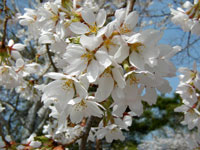 Sakura/cherry blossoms. Cherry blossoms are not unique to Japan, but their celebration in traditional culture certainly is. Japan loves sakura. Starting in the reaches of Kyushu around March, the sakura zensen (cherry-blossom front)sweeps across Japan eastwards until finally Hokkaido explodes into bloom in June. Some years, the sakura may come earlier, or they may come later. There is also an occasional phenomenon called aki zakura, or fall cherry blossoms, which may occur when the cold fall temperatures may rise for a warm period, confusing the trees into thinking that spring has already arrived, blossoming in November for a brief time. Everywhere in Japan you can find parks that are full of cherry trees, ensuring that each spring, the place will erupt into beautiful pink colors. When this happens, Japanese compete for spaces under these blossoms and have parties and enjoy the warm, spring weather. The celebration lasts into the evening hours. Red and white lanterns are lit, illuminating the blossoms from below. It is truly a sight to behold.
Sakura/cherry blossoms. Cherry blossoms are not unique to Japan, but their celebration in traditional culture certainly is. Japan loves sakura. Starting in the reaches of Kyushu around March, the sakura zensen (cherry-blossom front)sweeps across Japan eastwards until finally Hokkaido explodes into bloom in June. Some years, the sakura may come earlier, or they may come later. There is also an occasional phenomenon called aki zakura, or fall cherry blossoms, which may occur when the cold fall temperatures may rise for a warm period, confusing the trees into thinking that spring has already arrived, blossoming in November for a brief time. Everywhere in Japan you can find parks that are full of cherry trees, ensuring that each spring, the place will erupt into beautiful pink colors. When this happens, Japanese compete for spaces under these blossoms and have parties and enjoy the warm, spring weather. The celebration lasts into the evening hours. Red and white lanterns are lit, illuminating the blossoms from below. It is truly a sight to behold.
Sakura can be likened to the passing beauty of youth, or the passing of life itself. The blossoms show their beauty to the world, but this only lasts a few weeks and they flutter to the ground. If a strong wind comes along, this time of beauty can be cut even shorter. I used to shake the branches of the cherry trees to give my wife a sakura shower, although sometimes this would knock loose an occasional caterpillar. Mayu didn't enjoy when that happens. (Some caterpillars in Japan are dangerous, but I never figured out how that is.) Also, in Japan's attempt to make all sorts of weird ice cream flavors, there is also sakura ice cream, which is basically vanilla soft serve topped with powdered cherry blossoms. It looks pink and pretty, but the taste is rather unexciting. In fact, I thought it tasted slightly salty. Weird.
| |
 Shrines and temples. I'll be blunt. As a Christian, I am not interested in pursuing either the Buddhist or Shinto religions. However, I believe that most-if not all-world religions share many of the same truths and ideals. The elegant charm and peaceful tranquility of shrines and temples is so relaxing. The architecture, the silent meditative quality, and the contemplative nature of the gardens are something for everyone of any religion (or lack of) to enjoy and respect. Shrines and temples. I'll be blunt. As a Christian, I am not interested in pursuing either the Buddhist or Shinto religions. However, I believe that most-if not all-world religions share many of the same truths and ideals. The elegant charm and peaceful tranquility of shrines and temples is so relaxing. The architecture, the silent meditative quality, and the contemplative nature of the gardens are something for everyone of any religion (or lack of) to enjoy and respect.
| |
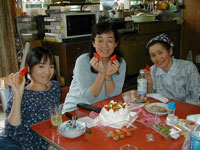
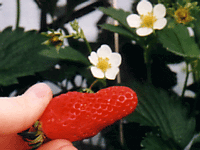 Strawberries. I don't know where you are from, but here in the American Southwest, strawberries are kinda hard and sour. Not so in Japan. Japanese strawberries are so sweet and soft that they practically melt in your mouth. So delicious! And whereas in America when you buy a package of strawberries and chances are that there are a few duds in the bunch, a package of strawberries bought in Japan is guaranteed to have delicious strawberries, every one of them.
Strawberries. I don't know where you are from, but here in the American Southwest, strawberries are kinda hard and sour. Not so in Japan. Japanese strawberries are so sweet and soft that they practically melt in your mouth. So delicious! And whereas in America when you buy a package of strawberries and chances are that there are a few duds in the bunch, a package of strawberries bought in Japan is guaranteed to have delicious strawberries, every one of them.
| |
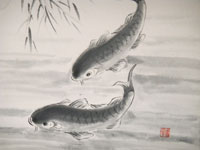 Sumi-e. Sumi-e is Japanese charcoal ink calligraphy painting. My Japanese grandmother gave me an introduction lesson on how to do this artwork several years ago, and I often practice this with her. Sumi-e is painted with a calligraphy brush, and the ink can be watered down to create different shades of gray. Mainly I've just painted simpe stuff like bamboo and cottages in the mountains and such. Nothing as fancy as what my grandmother can do. Sumi-e. Sumi-e is Japanese charcoal ink calligraphy painting. My Japanese grandmother gave me an introduction lesson on how to do this artwork several years ago, and I often practice this with her. Sumi-e is painted with a calligraphy brush, and the ink can be watered down to create different shades of gray. Mainly I've just painted simpe stuff like bamboo and cottages in the mountains and such. Nothing as fancy as what my grandmother can do.
| |
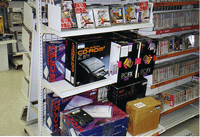 Otaku shops. OK, so this topic has been adequately represented enough already on my homepage that I won't spend much time writing about this topic. But I will just say that it is so awesome that cities like Tokyo and Osaka have entire shopping districts dedicated to stuff like this. This picture was taken inside Sofmap in Osaka's Den Den Town. Otaku shops. OK, so this topic has been adequately represented enough already on my homepage that I won't spend much time writing about this topic. But I will just say that it is so awesome that cities like Tokyo and Osaka have entire shopping districts dedicated to stuff like this. This picture was taken inside Sofmap in Osaka's Den Den Town.
| |
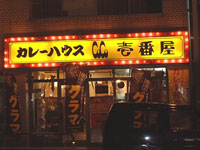 Curry. From what I understand, curry was introduced to Japan from England, which had originally come from India. I guess that's why Japanese curry is much more similar to Indian curry than it is Thai curry. Anyhow, Japanese curry has a flavor of its own. One popular chain of curry restaurants is Coco Ichibanya Curry House. This place allows you to select the level of spicyness, from 1 (kid's stuff) to 10 (yowch!). I can really go for spicy, but I think that once you get past level 7, the flavor is diminished by the spice level. Coco's allows you to choose whatever ingredients you lie, too. My favorite is eggplant and fried squid rings. You select the amount of rice you want, and pile on the fukujin pickles if you like. It's fantastic. Of course, there is also katsu curry, which has a slab of tonkatsu to go with the curry. Something new that I've recently discovered is Kanazawa curry, currently a popular favorite among Akihabara shoppers. I first read about this on Wired's Game Life Japan blog, and I decided to check it out. Last year I tried some at Go Go Curry, and it's pretty good. Kanazawa curry is more or less like a plate of tonkatsu (rice, shredded cabbage, and tonkatsu sauce) with curry sauce on top. You can also go crazy with it and add stuff like a fried egg or sausage on top. The curry sauce is also pretty unique too. Curry. From what I understand, curry was introduced to Japan from England, which had originally come from India. I guess that's why Japanese curry is much more similar to Indian curry than it is Thai curry. Anyhow, Japanese curry has a flavor of its own. One popular chain of curry restaurants is Coco Ichibanya Curry House. This place allows you to select the level of spicyness, from 1 (kid's stuff) to 10 (yowch!). I can really go for spicy, but I think that once you get past level 7, the flavor is diminished by the spice level. Coco's allows you to choose whatever ingredients you lie, too. My favorite is eggplant and fried squid rings. You select the amount of rice you want, and pile on the fukujin pickles if you like. It's fantastic. Of course, there is also katsu curry, which has a slab of tonkatsu to go with the curry. Something new that I've recently discovered is Kanazawa curry, currently a popular favorite among Akihabara shoppers. I first read about this on Wired's Game Life Japan blog, and I decided to check it out. Last year I tried some at Go Go Curry, and it's pretty good. Kanazawa curry is more or less like a plate of tonkatsu (rice, shredded cabbage, and tonkatsu sauce) with curry sauce on top. You can also go crazy with it and add stuff like a fried egg or sausage on top. The curry sauce is also pretty unique too.
| |
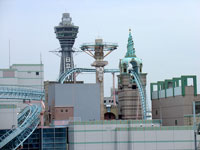 Urban roller coasters. Well, I know of at least one, in Osaka. The tracks twist around the buildings downtown. Pretty neat, huh? Urban roller coasters. Well, I know of at least one, in Osaka. The tracks twist around the buildings downtown. Pretty neat, huh?
| |
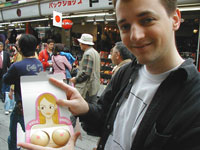 Flan/pudding. Japan may not have invented flan, but holy cow, they sure improved it. I'd never even had flan until I had Japanese flan, and because of that, I just don't care for non-Japanese flan very much. Even the European style (as opposed to the Mexican style in grocery stores in Phoenix) isn't as great. It is so smooth and wonderful. I worked with this one guy from Jordan who told me how much he loved flan, so I brought him some Japanese flan for him to try. He said it was the best he'd ever had, and he's tried a lot of flan. Score one for Japan! Flan/pudding. Japan may not have invented flan, but holy cow, they sure improved it. I'd never even had flan until I had Japanese flan, and because of that, I just don't care for non-Japanese flan very much. Even the European style (as opposed to the Mexican style in grocery stores in Phoenix) isn't as great. It is so smooth and wonderful. I worked with this one guy from Jordan who told me how much he loved flan, so I brought him some Japanese flan for him to try. He said it was the best he'd ever had, and he's tried a lot of flan. Score one for Japan!Oh yeah, and Japan can have a weird sense of humor about pudding too. This picture is of me embarrassing my dear friend Galen with some pudding boobs in Asakusa's Nakamise. Yummy! | |
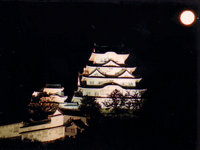 Castles. A town with a castle is very fortunate. Even in the most modern of cities, these castles are jewels that stand as testaments to Japan's long, rich history. At night, these castles are illuminated with spot lights, causing them to glow like white beacons to the world. When I lived in Himeji, the spectacular view of Himeji Castle was visible from my apartment window. Himeji castle has to be the best castle in Japan. In the evenings, Mayu and I enjoyed walking and riding our bicycles around the castle at night. The surrounding moat was home to many ducks, and we believe that one in particular was our friend as she would follow us as we walked along the path, muttering,"Peh peh, peh peh." The moat was also home to so many wonderful turtles, and Mayu simply loves turtles. We would buy turtle food to toss into the water to feed these wonderful amphibians during the day. Benches were scattered around the perimeter of the castle, where one could sit and just gaze at the castle. Behind the castle was a nice, grassy park. We would toss our Frisbee back and forth in that park. The front also had a grassy area lined with cherry trees, and the grounds would explode with pink every spring. I really miss that castle. Castles. A town with a castle is very fortunate. Even in the most modern of cities, these castles are jewels that stand as testaments to Japan's long, rich history. At night, these castles are illuminated with spot lights, causing them to glow like white beacons to the world. When I lived in Himeji, the spectacular view of Himeji Castle was visible from my apartment window. Himeji castle has to be the best castle in Japan. In the evenings, Mayu and I enjoyed walking and riding our bicycles around the castle at night. The surrounding moat was home to many ducks, and we believe that one in particular was our friend as she would follow us as we walked along the path, muttering,"Peh peh, peh peh." The moat was also home to so many wonderful turtles, and Mayu simply loves turtles. We would buy turtle food to toss into the water to feed these wonderful amphibians during the day. Benches were scattered around the perimeter of the castle, where one could sit and just gaze at the castle. Behind the castle was a nice, grassy park. We would toss our Frisbee back and forth in that park. The front also had a grassy area lined with cherry trees, and the grounds would explode with pink every spring. I really miss that castle.
| |
 Domo-kun. Domo-kun has come a long way from being just an Internet meme of doing God's dirty work by killing kittens. He now has merchandising to be found in stores across America and has even been shown on TV here, too. Over ten years ago, I never would have guessed that NHK's cute mascot for its BS channels would have gained such recognition in the USA. Way to go, Domo! Domo-kun. Domo-kun has come a long way from being just an Internet meme of doing God's dirty work by killing kittens. He now has merchandising to be found in stores across America and has even been shown on TV here, too. Over ten years ago, I never would have guessed that NHK's cute mascot for its BS channels would have gained such recognition in the USA. Way to go, Domo!
| |
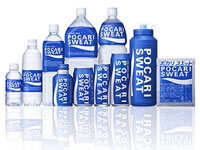 Pocari Sweat. You can cover a lot of ground, hiking all over Japan in the summertime. Whether it's the urban sprawl or the beautiful countryside, you will see some memorable sights. But with the humid summers, you will sweat quite a lot. That's why it is essential to balance your electrolytes. I highly recommend Pocari Sweat. Pocari Sweat has been exported to at least Korea, but the strange name is what keeps it from catching on in the US. That and the fact that disgusting American sports drinks have to be loaded with so much high fructose corn syrup sweentner that Pocari Sweat may taste subtly salty. But guess what? Your sweat is salty, and that salt is what you need or else you'll get sick if you lose too much of it. So drink up, and you'll be sure to find plenty of Pocari Sweat at convenience stores and vending machines across the country. Oh yeah, Coca Cola's Aquarius is good too, but I just prefer the flavor of Pocari Sweat. Pocari Sweat. You can cover a lot of ground, hiking all over Japan in the summertime. Whether it's the urban sprawl or the beautiful countryside, you will see some memorable sights. But with the humid summers, you will sweat quite a lot. That's why it is essential to balance your electrolytes. I highly recommend Pocari Sweat. Pocari Sweat has been exported to at least Korea, but the strange name is what keeps it from catching on in the US. That and the fact that disgusting American sports drinks have to be loaded with so much high fructose corn syrup sweentner that Pocari Sweat may taste subtly salty. But guess what? Your sweat is salty, and that salt is what you need or else you'll get sick if you lose too much of it. So drink up, and you'll be sure to find plenty of Pocari Sweat at convenience stores and vending machines across the country. Oh yeah, Coca Cola's Aquarius is good too, but I just prefer the flavor of Pocari Sweat.
| |
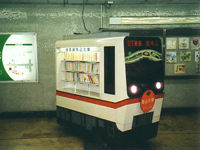 The library in Nishi Magome Station. From Gotanda Station, take the Asakusa Subway Line to Nishi Magome Station. It's been many years since I was there, but there you should find a small library inside that station. The bookshelf is shaped like a small subway train, and it even lights up. The books are donated by commuters, and the books are borrowed on an honors system. See a book you like, borrow it, give it back. Donate your own books. Pretty cool, huh? This is a testament to the solidity of Japanese culture. I cannot imagine something like this existing in the Los Angeles subway and not have it vandalized and the books stolen. The library in Nishi Magome Station. From Gotanda Station, take the Asakusa Subway Line to Nishi Magome Station. It's been many years since I was there, but there you should find a small library inside that station. The bookshelf is shaped like a small subway train, and it even lights up. The books are donated by commuters, and the books are borrowed on an honors system. See a book you like, borrow it, give it back. Donate your own books. Pretty cool, huh? This is a testament to the solidity of Japanese culture. I cannot imagine something like this existing in the Los Angeles subway and not have it vandalized and the books stolen.
| |
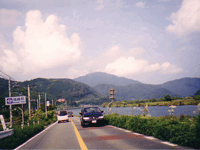 Countryside driving. Country roads, take me home.... Or, it's just fun to just get in your car and just drive all over the countryside. Find your way or lose your way; either way you will find beauty. See towns you may never see again, and just follow your heart until you're either content or you run out of gas money and need to turn back. Mayu and I would just drive with no destination in mind, past waterfalls, fields of flowers, lakes, down winding mountain rows or through the valleys, admiring the trees and the clean skies. Countryside driving. Country roads, take me home.... Or, it's just fun to just get in your car and just drive all over the countryside. Find your way or lose your way; either way you will find beauty. See towns you may never see again, and just follow your heart until you're either content or you run out of gas money and need to turn back. Mayu and I would just drive with no destination in mind, past waterfalls, fields of flowers, lakes, down winding mountain rows or through the valleys, admiring the trees and the clean skies.
| |
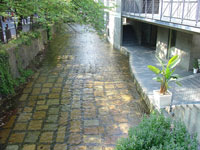
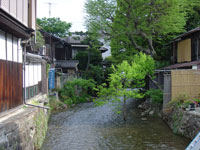 Unexpected urban beauty. While walking the streets of Japanese cities, you may find peaceful, serene beauty when you are not expecting it. Canals passing through neighborhoods are particularly beautiful. Perhaps Japanese people take these for granted, but from the dry desert I come from, these are like urban oasises. Or do you say oases? Yeah, spell check likes oases. That's my new word now. Unexpected urban beauty. While walking the streets of Japanese cities, you may find peaceful, serene beauty when you are not expecting it. Canals passing through neighborhoods are particularly beautiful. Perhaps Japanese people take these for granted, but from the dry desert I come from, these are like urban oasises. Or do you say oases? Yeah, spell check likes oases. That's my new word now.
| |
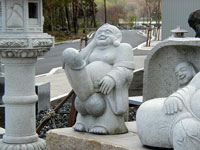 Goofy-ass sexual shit. So who says Asian men have small penises? Check out Buddha there, rockin' a big cock! And check out his look of embarrassment on his face. "Well son of a gun, that just flew up there on its own! It just has a mind of its own sometimes." I guess that's how he obtains nirvana. I mean, really! What kind of person would buy this Buddha with a boner statue to put in their garden? They're either very sexually liberated or very shackled by their sexuality. My bet is the latter. Goofy-ass sexual shit. So who says Asian men have small penises? Check out Buddha there, rockin' a big cock! And check out his look of embarrassment on his face. "Well son of a gun, that just flew up there on its own! It just has a mind of its own sometimes." I guess that's how he obtains nirvana. I mean, really! What kind of person would buy this Buddha with a boner statue to put in their garden? They're either very sexually liberated or very shackled by their sexuality. My bet is the latter.Yes, Japan has brought the world some cool stuff like the rabbit-eared vibrators and such, but it is also infamous for some pretty weird sexual crap too. This is both a good thing (entertainment value) or a bad thing (eye-gouging things you cannot unsee). It can be innocent and cute (such as the infamous Hello Kitty vibrator), or weird stuff (I'd rather not say). This is the sort of stuff that spurs the reaction, "JAPAN, WTF? LOL!" | |
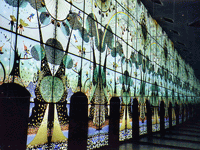 Art. Japanese art amazes me with its simplicity and its charm. Again, my favorite contemporary Japaense artist is Seiji Fujishiro, whom I wrote about previously in another essay. Although photography is not allowed in the museums, I was naughty and took the picture here (it turned out well despite being a low-light level photograph). Japanese art can be so simplisticly expressive of such deep emotion and gentle feelings, evoking nostalgia and a love of the beauty of the world. This kindness in art needs to be more internationally known. Much of American modern art, in my opinion, can get so caught up in the details that it loses the focus on the emotional aspect. Art. Japanese art amazes me with its simplicity and its charm. Again, my favorite contemporary Japaense artist is Seiji Fujishiro, whom I wrote about previously in another essay. Although photography is not allowed in the museums, I was naughty and took the picture here (it turned out well despite being a low-light level photograph). Japanese art can be so simplisticly expressive of such deep emotion and gentle feelings, evoking nostalgia and a love of the beauty of the world. This kindness in art needs to be more internationally known. Much of American modern art, in my opinion, can get so caught up in the details that it loses the focus on the emotional aspect.
| |
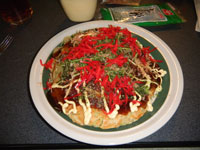 Okonomiyaki. Again, I can't stop talking about TEH NOMZ. Although I haven't been to the Kansai area since '04, I lived in Himeji for two years and I consider it my second hometown. I am a bit of a Kansai guy, and I really enjoyed the relaxed, friendlier culture there than the stuffy, formal Kanto culture. Several Kansai-ben (dialect) words are a part of my usual Japanese vocabulary, such as honma, metcha, nambo, and chau chau. That being said, okonomiyaki in kansai is the best. Some may say that Hiroshima has the best okonomiyaki, but I am a bit biased. I know for sure that Osaka okonomiyaki beats Tokyo okonomiyaki for sure. Once in Ikebukuro, I ordered some monju yaki and it literally looked like grilled puke. But it wasn't America, so I couldn't just ask the waitress to take it back and give me something else. My favorite is modan yaki, or "modern style" okonomiyaki. This is with yakisoba noodles, and it's TEH AWESOME. Add bacon, squid, a fried egg, and top it with okonomiyaki sauce, mayonnaise, kizami shoga (pickled ginger), katsuo (dried, shaved bonito), and aonori (green seaweed powder). YUM! Okonomiyaki. Again, I can't stop talking about TEH NOMZ. Although I haven't been to the Kansai area since '04, I lived in Himeji for two years and I consider it my second hometown. I am a bit of a Kansai guy, and I really enjoyed the relaxed, friendlier culture there than the stuffy, formal Kanto culture. Several Kansai-ben (dialect) words are a part of my usual Japanese vocabulary, such as honma, metcha, nambo, and chau chau. That being said, okonomiyaki in kansai is the best. Some may say that Hiroshima has the best okonomiyaki, but I am a bit biased. I know for sure that Osaka okonomiyaki beats Tokyo okonomiyaki for sure. Once in Ikebukuro, I ordered some monju yaki and it literally looked like grilled puke. But it wasn't America, so I couldn't just ask the waitress to take it back and give me something else. My favorite is modan yaki, or "modern style" okonomiyaki. This is with yakisoba noodles, and it's TEH AWESOME. Add bacon, squid, a fried egg, and top it with okonomiyaki sauce, mayonnaise, kizami shoga (pickled ginger), katsuo (dried, shaved bonito), and aonori (green seaweed powder). YUM!
| |
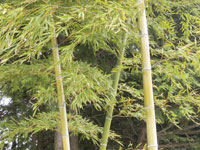 Bamboo. Coming from Japan, my wife sees bamboo as just another tree. But from my perspective, bamboo is a symbol of the exotic beauty of Asia. Bamboo are graceful and beautiful Plus, its sturdiness makes it very useful. Bamboo. Coming from Japan, my wife sees bamboo as just another tree. But from my perspective, bamboo is a symbol of the exotic beauty of Asia. Bamboo are graceful and beautiful Plus, its sturdiness makes it very useful.
| |
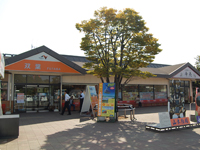 Highway service areas. The majority of highways in Japan require a toll to travel. This can make long road trips expensive, and it limits you to staying on the highway instead of exiting and re-entering. You could exit the highway to visit a favorite restaurant or whatever in a given town to eat at and to stretch your legs, but then you'd have to pay once you exit. So instead, the highways have service areas that are facilities to get gas, use a restroom, load up on snacks, eat at a restaurant, or even to buy souvenirs. One I visit quite a lot is the Futaba Service Area, along the Chuou Expressway that goes up from Tokyo to Okaya in Nagano-ken, then curves east and heads to Nagoya. The bus that runs between Tokyo and Nagano-ken where my family lives stops at Futaba going both ways. A typical service area will have a convenience store selling drinks, snacks, etc; a restaurant in which you can buy a meal ticket via a ticket vending machine and enjoy a bowl of udon or a plate of curry; plenty of vending machines, a bakery, and often you will see regular restaurants as well. My mom-in-law has a service area mania, and I can respect this since I have a train mania myself and can relate (amonth many other manias). Most will have outside vendors selling "weird food on sticks" (see above), stuff like takoyaki, fried chicken, corn dogs (called "American dogs") as well as soft serve ice cream. Again, in Japan's pursuit of creating ice cream flavors that are weird, many of these service areas try to develop their own weird specialty soft serve ice cream---often attempting to include the specialty of the area the service area is. Some are great, such as blueberry or macha (green tea), but some are pretty bizarre, such as curry or wasabi ice cream. I've tried both of these flavors, and while neither of them are strong enough to make the ice cream taste gross, my only question is, "WHY?" It's like they make bizarre flavors just for the sake of it. Highway service areas. The majority of highways in Japan require a toll to travel. This can make long road trips expensive, and it limits you to staying on the highway instead of exiting and re-entering. You could exit the highway to visit a favorite restaurant or whatever in a given town to eat at and to stretch your legs, but then you'd have to pay once you exit. So instead, the highways have service areas that are facilities to get gas, use a restroom, load up on snacks, eat at a restaurant, or even to buy souvenirs. One I visit quite a lot is the Futaba Service Area, along the Chuou Expressway that goes up from Tokyo to Okaya in Nagano-ken, then curves east and heads to Nagoya. The bus that runs between Tokyo and Nagano-ken where my family lives stops at Futaba going both ways. A typical service area will have a convenience store selling drinks, snacks, etc; a restaurant in which you can buy a meal ticket via a ticket vending machine and enjoy a bowl of udon or a plate of curry; plenty of vending machines, a bakery, and often you will see regular restaurants as well. My mom-in-law has a service area mania, and I can respect this since I have a train mania myself and can relate (amonth many other manias). Most will have outside vendors selling "weird food on sticks" (see above), stuff like takoyaki, fried chicken, corn dogs (called "American dogs") as well as soft serve ice cream. Again, in Japan's pursuit of creating ice cream flavors that are weird, many of these service areas try to develop their own weird specialty soft serve ice cream---often attempting to include the specialty of the area the service area is. Some are great, such as blueberry or macha (green tea), but some are pretty bizarre, such as curry or wasabi ice cream. I've tried both of these flavors, and while neither of them are strong enough to make the ice cream taste gross, my only question is, "WHY?" It's like they make bizarre flavors just for the sake of it.
| |
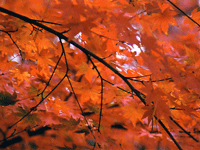 Autumn leaves. They say in Japan that autumn is a time for reading books. It is also a time for taking in the beauty of the colors changing. Just as the sakura zensen sweeps across Japan from the southwest to the northeast, the Autumn leaves. They say in Japan that autumn is a time for reading books. It is also a time for taking in the beauty of the colors changing. Just as the sakura zensen sweeps across Japan from the southwest to the northeast, the | |
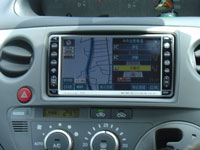 Car Navigation. I first saw a car navi was on my first trip to Japan in 1998. It really impressed me, and these are quite common in cars in Japan. People have these in America too, but you don't often see them built into the dashboards of cars, perhaps in fear of having them stolen or something. Most people use car navi on their Droid or Blackberry cell phones or something attachable to their dashboard. Car Navigation. I first saw a car navi was on my first trip to Japan in 1998. It really impressed me, and these are quite common in cars in Japan. People have these in America too, but you don't often see them built into the dashboards of cars, perhaps in fear of having them stolen or something. Most people use car navi on their Droid or Blackberry cell phones or something attachable to their dashboard.
| |
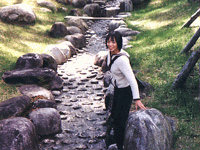 Parks. Up in the mountains of Nagano-ken, there are public parks that are so beautiful and serene. Some of the ones we go to the most are in Komagane and Ina. These parks represent the natural beauty of nature, yet they are still somewhat man-made because they are specifically parks. So it's more like a manufactured representation of nature, if that makes sense. There are paths, tables, ponds with fountains, and man-made waterways with bridges and such to prevent children from getting hurt or whatnot. So park your car, bring a blanket, lay out and relax. If you have children, there are play areas for them too. Parks. Up in the mountains of Nagano-ken, there are public parks that are so beautiful and serene. Some of the ones we go to the most are in Komagane and Ina. These parks represent the natural beauty of nature, yet they are still somewhat man-made because they are specifically parks. So it's more like a manufactured representation of nature, if that makes sense. There are paths, tables, ponds with fountains, and man-made waterways with bridges and such to prevent children from getting hurt or whatnot. So park your car, bring a blanket, lay out and relax. If you have children, there are play areas for them too.
| |
 Modern architecture. Japan is a showcase of both traditional and futuristic architecture. Travel books and whatnot describe places like Odaiba and Yokohama's Minato Mirai 21 as appearing as settings of a futuristic science fiction movie. The picture to the left is of Kyoto Station. This beautiful, open air atrium is a perfect example of modern architecture. Kyoto Station stands as a striking contrast to the beauty of traditional Kyoto architecture. Modern architecture. Japan is a showcase of both traditional and futuristic architecture. Travel books and whatnot describe places like Odaiba and Yokohama's Minato Mirai 21 as appearing as settings of a futuristic science fiction movie. The picture to the left is of Kyoto Station. This beautiful, open air atrium is a perfect example of modern architecture. Kyoto Station stands as a striking contrast to the beauty of traditional Kyoto architecture.
| |
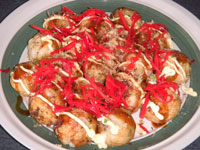 Takoyaki. Pieces of octopus baked in dough balls, topped with okonomiyaki sauce, mayonnaise, katsuo, aonori, and kizami shouga. An Osaka specialty, and a favorite at matsuri (festivals). Takoyaki. Pieces of octopus baked in dough balls, topped with okonomiyaki sauce, mayonnaise, katsuo, aonori, and kizami shouga. An Osaka specialty, and a favorite at matsuri (festivals).
| |
 Money. Japanese money just feels better in my hands. The paper bills are colorful and have cool-looking holograms embedded in them. Coins are larger than puny United States coins and feel like real coins in my hands. Also, paper bills don't begin until 1,000 yen. The faces on Japanese currency are not of Japanese politicians (for there are so very few ones to be proud of), but instead they are of famous authors. This makes sense, considering the high literacy rate of the nation. Money. Japanese money just feels better in my hands. The paper bills are colorful and have cool-looking holograms embedded in them. Coins are larger than puny United States coins and feel like real coins in my hands. Also, paper bills don't begin until 1,000 yen. The faces on Japanese currency are not of Japanese politicians (for there are so very few ones to be proud of), but instead they are of famous authors. This makes sense, considering the high literacy rate of the nation.
| |
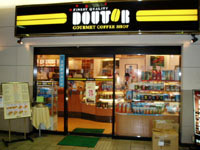 Cafes. Yeah, Japan has Starbucks too. I don't know why, but I really just like Japanese cafes (kissaten or "tea houses"). Whether it's a coffee shop or a typical cafe, they're just charming in a way I can't describe. One of my favorite chains in the Kansai area is Cafe de Crie. They have great sandwiches and awesome drinks. Cafes. Yeah, Japan has Starbucks too. I don't know why, but I really just like Japanese cafes (kissaten or "tea houses"). Whether it's a coffee shop or a typical cafe, they're just charming in a way I can't describe. One of my favorite chains in the Kansai area is Cafe de Crie. They have great sandwiches and awesome drinks.
| |
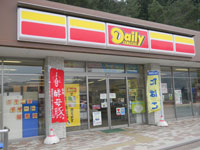 Combini (Convenience stores). Japanese convenience stores, in my opinion, are so superior to American ones. You can pay bills and even make travel arrangements (at least at Family Mart). You can find the coolest stuff in there. I pre-ordered Sen to Chihiro when it first was released on DVD in Japan. Heck, I've even found plastic models for sale there. Tasty J-snacks, great drinks, huge racks of magazines and manga, and all sorts of decent stuff, such as earphones for portable audio devices and such. Combini (Convenience stores). Japanese convenience stores, in my opinion, are so superior to American ones. You can pay bills and even make travel arrangements (at least at Family Mart). You can find the coolest stuff in there. I pre-ordered Sen to Chihiro when it first was released on DVD in Japan. Heck, I've even found plastic models for sale there. Tasty J-snacks, great drinks, huge racks of magazines and manga, and all sorts of decent stuff, such as earphones for portable audio devices and such.
| |
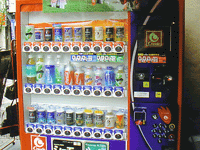 Vending Machines. Vending machines in Japan are legendary. You can buy hot drinks out of vending machines. You can find vending machines EVERYWHERE in Japan. And whereas in the United States where you can only buy corn syrup that gives you diabetes, fake sugar that makes your brain hurt, and just plain water, Japanese vending machines provide a great selection of drinks. From vitamin boosts, healthy energy drinks, soda, unsweetened iced tea in so many varieties, to electrolyte balancers such as Pocari Sweat and Aquarius, you can also get warm cans of coffee, cocoa, and even corn potage soup. Vending Machines. Vending machines in Japan are legendary. You can buy hot drinks out of vending machines. You can find vending machines EVERYWHERE in Japan. And whereas in the United States where you can only buy corn syrup that gives you diabetes, fake sugar that makes your brain hurt, and just plain water, Japanese vending machines provide a great selection of drinks. From vitamin boosts, healthy energy drinks, soda, unsweetened iced tea in so many varieties, to electrolyte balancers such as Pocari Sweat and Aquarius, you can also get warm cans of coffee, cocoa, and even corn potage soup.
| |
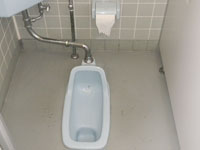 Toilets. Japanese toilets are great. Even the traditional ones in which you basically squat over the basin set into the floor of the restroom. Think about it: how many times have you hassled to get the stupid paper toilet seat cover onto the seat, only to have it fall into the water and you have to get another one out? Well, with the traditional "squat over the hole in the floor" type of toilet, you won't have to bother with using those paper cowboy hats, saving the environment. The only catch is that you can't be a wimpy fat-ass with zero muscle mass in your legs. Toilets. Japanese toilets are great. Even the traditional ones in which you basically squat over the basin set into the floor of the restroom. Think about it: how many times have you hassled to get the stupid paper toilet seat cover onto the seat, only to have it fall into the water and you have to get another one out? Well, with the traditional "squat over the hole in the floor" type of toilet, you won't have to bother with using those paper cowboy hats, saving the environment. The only catch is that you can't be a wimpy fat-ass with zero muscle mass in your legs. So now let's take a look at regular sit-down toilets in Japan. Pretty much all of them have two flushing options: big and small. Small is for your number one, big is for your number two. This enables so much water conservation that it's such a genius idea. If only stupid Americans were capable of understanding such things. Americans can't even figure out the dynamics of recycling, let alone deciding which category their body waste falls under. Many toilets, including the one pictured below, has a little faucet in which you can rinse your hands off with as the water fills up the toilet's tank. Neat! Now, many of these toilets are electronic. I jokingly refer to these as Darth Vader toilets, a tribute to a remark by Michael Knight in the first episode of Knight Rider when he is introduced to K.I.T.T.'s computer module. Anyhow, these have elctronic push-button flush mechanisms, seat warming options, an "oshiri" ("butt") button to squirt your backside, and a bidet button for the lovely girl parts. So high-tech! Perhaps in the future, Japan will invent a toilet that will predict your future when you sit on the seat?
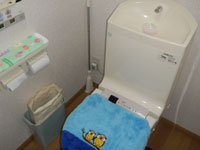
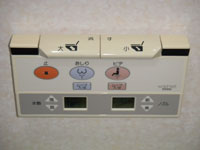 | |
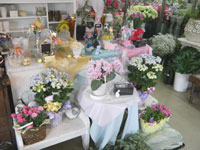 Flower shops. Wow, look! Flower shops that sell real flowers? Now, I've been to San Francisco, and I've seen that they have real flower shops there too. In many ways, San Francisco reminded me of Tokyo. But at least here in Phoenix, so many of them are boring, their selection of flowers is limited, and a whole lot of their inventory is just fake flower arrangements. Boring! In Japan, flower shops can get rather busy with constant customer traffic. Japan is a country that buys a lot of flowers, and I respect that. Flower shops. Wow, look! Flower shops that sell real flowers? Now, I've been to San Francisco, and I've seen that they have real flower shops there too. In many ways, San Francisco reminded me of Tokyo. But at least here in Phoenix, so many of them are boring, their selection of flowers is limited, and a whole lot of their inventory is just fake flower arrangements. Boring! In Japan, flower shops can get rather busy with constant customer traffic. Japan is a country that buys a lot of flowers, and I respect that.
| |
 Bathrooms. Japan is a country that takes bathing seriously, and Japanese bathrooms make so much sense. The tub and the shower are in the same room, right next to each other. Clean yourself under the shower, then relax in the tub. Internal heaters keep the bathwater warm so that the whole family can enjoy relaxing in the bath without having to empty and refill the water, thereby saving lots of water. And that's why it is necessary to get clean before hopping into the tub! Bathrooms. Japan is a country that takes bathing seriously, and Japanese bathrooms make so much sense. The tub and the shower are in the same room, right next to each other. Clean yourself under the shower, then relax in the tub. Internal heaters keep the bathwater warm so that the whole family can enjoy relaxing in the bath without having to empty and refill the water, thereby saving lots of water. And that's why it is necessary to get clean before hopping into the tub!
| |
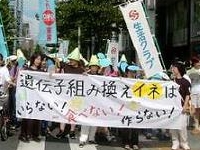 Japan prohibits/restricts genetically modified foods. This topic is very important to me. The more I read about the Monsanto corporation and genetically engineered foods, the more fearful I am of the world being corrupted by the altered DNA that their scientists have introduced. Do a lot of research, you will find a very strong correlation between the introduction of GMO foods and a sudden epidemic of health problems, ranging from food allergies to mental health conditions. The evidence is overwhelming, but since total isolation is essentially impossible and since the effects are subtle and spread out over many years, a control group cannot be formed, so Monsanto claims that there is no problems with the works of their mad scientists. They claim that GMO crops will help to end world hunger, yet they coerce farmers who do not use their seeds while simultaneously hiking the prices of their seed. It is criminal, in my opinion, and genetically altered foods need to be eradicated. Japan prohibits/restricts genetically modified foods. This topic is very important to me. The more I read about the Monsanto corporation and genetically engineered foods, the more fearful I am of the world being corrupted by the altered DNA that their scientists have introduced. Do a lot of research, you will find a very strong correlation between the introduction of GMO foods and a sudden epidemic of health problems, ranging from food allergies to mental health conditions. The evidence is overwhelming, but since total isolation is essentially impossible and since the effects are subtle and spread out over many years, a control group cannot be formed, so Monsanto claims that there is no problems with the works of their mad scientists. They claim that GMO crops will help to end world hunger, yet they coerce farmers who do not use their seeds while simultaneously hiking the prices of their seed. It is criminal, in my opinion, and genetically altered foods need to be eradicated.
| |
| Suica cards. I didn't get a Suica card until 2006. When i did, I was glad I did so. No longer did I have to worry about standing in line to buy tickets at the train station. All I had to do was swipe the card across the sensor panel at the ticket gate to enter and board trains and subways. Not only can the Suica card be used for transportation, but vending machines, convenience stores, supermarkets, and even many family-style restaurants accept payment from these pre-paid cards. You can charge the card at the ticket machines at train stations and convenience stores.
| |
| Japan Post. By the end of my second year living in Himeji, I realized that I had lived in Japan for a while when I had to ask somebody, "What is yuubinkyoku in English?" The reply was something like, "'Post office,' you goofball." The postal service in Japan is great. Not only is it cheaper and more efficient to send stuff in Japan than it is back in the States, but they treat you better and they take better care of your stuff, too. For example, if you have a video game mailed to you in a bubble envelope in the USA, you can be almost guaranteed that the paper box would get smashed or the plastic case would get shattered. Not so in Japan. The postal delivery carriers in Japan handle your packages gently. I have had many video games sent to me in bubble mailers. In America, even if these items are wrapped in bubble wrap snugly, they will still get crushed as the mail carriers there will try to cram them in between loads and loads of junk mail, which is another thing I do not see much of in Japan. Not only that, but Japan Post also has a savings bank account you can open. Unlike banks where they charge you for wiring money (furikomi) to accounts at other banks, the JP Yuuchou Bank is nation-wide, and thus uou can make money transfers to other Yuuchou accounts free of charge. This is especially great for paying for auctions on Yahoo Auctions Japan, which I will discuss next.
| |
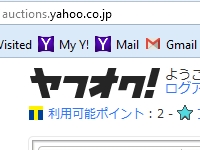 Yahoo Auctions Japan. Among my friends we call this service YAJ. On YAJ, you can find all sorts of neat crap that you can't find on eBay. Even if you could, you are nearly certain to spend way more as a result. Having access to YAJ is a gateway to a whole world of all sorts of neat Japanese crap. Also, YAJ renders auction sniping useless, since bidding on something at the last minute (or last few seconds, rather) will extend the auction a little while to allow other bidders another chance. YAJ offers a great community of sellers, and it is not uncommon for a seller to ship the item before they even confirm payment. You'd never see that on eBay, I bet. Yahoo Auctions Japan. Among my friends we call this service YAJ. On YAJ, you can find all sorts of neat crap that you can't find on eBay. Even if you could, you are nearly certain to spend way more as a result. Having access to YAJ is a gateway to a whole world of all sorts of neat Japanese crap. Also, YAJ renders auction sniping useless, since bidding on something at the last minute (or last few seconds, rather) will extend the auction a little while to allow other bidders another chance. YAJ offers a great community of sellers, and it is not uncommon for a seller to ship the item before they even confirm payment. You'd never see that on eBay, I bet.
| |
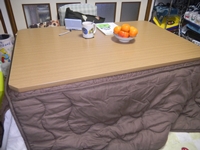 Kotatsu. In the cold of winter, nothing beats spending a lazy day snuggling under the kotatsu, drinking hot tea and eating mikan (tangerines). In this picture, I'm all set up for studying for the JLPT (Japanese Langauge Proficiency Test), complete with my Nintendo DS to look up unfamiliar kanji. The only downside to sitting under a kotatsu table is being hunched over with no back support, so I always sit on a zaisu (floor chair) to support my lower back. Kotatsu. In the cold of winter, nothing beats spending a lazy day snuggling under the kotatsu, drinking hot tea and eating mikan (tangerines). In this picture, I'm all set up for studying for the JLPT (Japanese Langauge Proficiency Test), complete with my Nintendo DS to look up unfamiliar kanji. The only downside to sitting under a kotatsu table is being hunched over with no back support, so I always sit on a zaisu (floor chair) to support my lower back.
Gachapon. Capsule toys in Japan are cool and can be found everywhere.
| |
 Read about my favorite manga in my next essay.
Read about my favorite manga in my next essay.
 Go back to the "Greg's Life" Table of Contents
Go back to the "Greg's Life" Table of Contents
"Anytime I see something screech across a room and latch onto someone's neck, and the guy screams and tries to get it off, I have to laugh, because what is that thing?" ---Jack Handey
mail: greg -atsign- stevethefish -dot- net